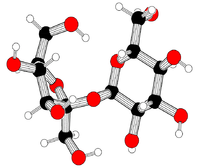Granulated sugar
 |
|
 |
|
 |
|
| Names | |
|---|---|
|
IUPAC name
(2R,3R,4S,5S,6R)-2-[(2S,3S,4S,5R)-3,4-dihydroxy-2,5-bis(hydroxymethyl)oxolan-2-yl]oxy-6-(hydroxymethyl)oxane-3,4,5-triol
|
|
| Other names
Sugar; Saccharose; α-D-glucopyranosyl-(1→2)-β-D-fructofuranoside;
β-D-fructofuranosyl-(2→1)-α-D-glucopyranoside; β-(2S,3S,4S,5R)-fructofuranosyl-α-(1R,2R,3S,4S,5R)-glucopyranoside; α-(1R,2R,3S,4S,5R)-glucopyranosyl-β-(2S,3S,4S,5R)-fructofuranoside |
|
| Identifiers | |
|
3D model (JSmol)
|
|
| ChEBI | |
| ChemSpider | |
| DrugBank | |
| ECHA InfoCard | 100.000.304 |
|
PubChem CID
|
|
| RTECS number | WN6500000 |
| UNII | |
|
|
|
|
| Properties | |
| C12H22O11 | |
| Molar mass | 342.30 g/mol |
| Appearance | white solid |
| Density | 1.587 g/cm3, solid |
| Melting point | None; decomposes at 186 °C (367 °F; 459 K) |
| 2000 g/L (25 °C) | |
| log P | −3.76 |
| Structure | |
| Monoclinic | |
| P21 | |
| Hazards | |
| Safety data sheet | ICSC 1507 |
| NFPA 704 | |
| Lethal dose or concentration (LD, LC): | |
|
LD50 (median dose)
|
29700 mg/kg (oral, rat) |
| US health exposure limits (NIOSH): | |
|
PEL (Permissible)
|
TWA 15 mg/m3 (total) TWA 5 mg/m3 (resp) |
|
REL (Recommended)
|
TWA 10 mg/m3 (total) TWA 5 mg/m3 (resp) |
|
IDLH (Immediate danger)
|
N.D. |
| Related compounds | |
|
Related compounds
|
Lactose Maltose |
|
Except where otherwise noted, data are given for materials in their standard state (at 25 °C [77 °F], 100 kPa).
|
|
|
|
|
| Infobox references | |
| Nutritional value per 100 g (3.5 oz) | |
|---|---|
| Energy | 1,620 kJ (390 kcal) |
|
100 g
|
|
|
0 g
|
|
|
0 g
|
|
| Vitamins | |
| Thiamine (B1) |
(0%)
0 mg |
| Riboflavin (B2) |
(0%)
0 mg |
| Niacin (B3) |
(0%)
0 mg |
| Vitamin C |
(0%)
0 mg |
| Minerals | |
| Iron |
(0%)
0 mg |
| Phosphorus |
(0%)
0 mg |
| Potassium |
(0%)
2.0 mg |
| Selenium |
(1%)
0.6 μg |
|
|
|
|
|
| Percentages are roughly approximated using US recommendations for adults. Source: USDA Nutrient Database |
|
β-D-fructofuranosyl-(2→1)-α-D-glucopyranoside; β-(2S,3S,4S,5R)-fructofuranosyl-α-(1R,2R,3S,4S,5R)-glucopyranoside; α-(1R,2R,3S,4S,5R)-glucopyranosyl-β-(2S,3S,4S,5R)-fructofuranoside
, dodecacarbon monodecahydrate
Sucrose is a common, naturally occurring carbohydrate found in many plants and plant parts. Saccharose is an obsolete name for sugars in general, especially sucrose. The molecule is a disaccharide combination of the monosaccharides glucose and fructose with the formula C12H22O11.
Sucrose is often extracted and refined from either cane or beet sugar for human consumption. Modern industrial sugar refinement processes often involves bleaching and crystallization also, producing a white, odorless, crystalline powder with a sweet taste of pure sucrose, devoid of vitamins and minerals. This refined form of sucrose is commonly referred to as table sugar or just sugar. It plays a central role as an additive in food production and food consumption all over the world. About 175 million metric tons of sucrose sugar were produced worldwide in 2013.
The word "sucrose" was coined in 1857 by the English chemist William Miller from the French sucre ("sugar") and the generic chemical suffix for sugars -ose. The abbreviated term Suc is often used for sucrose in scientific literature.
In sucrose, the components glucose and fructose are linked via an ether bond between C1 on the glucosyl subunit and C2 on the fructosyl unit. The bond is called a glycosidic linkage. Glucose exists predominantly as two isomeric "pyranoses" (α and β), but only one of these forms links to the fructose. Fructose itself exists as a mixture of "furanoses", each of which having α and β isomers, but only one particular isomer links to the glucosyl unit. What is notable about sucrose is that, unlike most disaccharides, the glycosidic bond is formed between the reducing ends of both glucose and fructose, and not between the reducing end of one and the nonreducing end of the other. This linkage inhibits further bonding to other saccharide units. Since it contains no anomeric hydroxyl groups, it is classified as a non-reducing sugar.
...
Wikipedia

